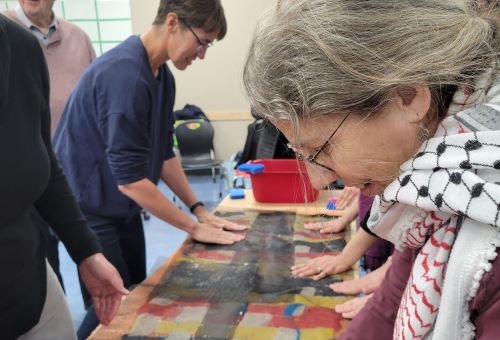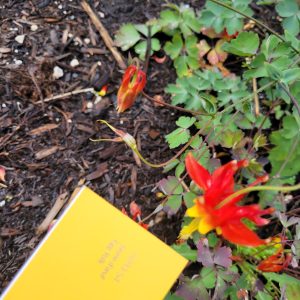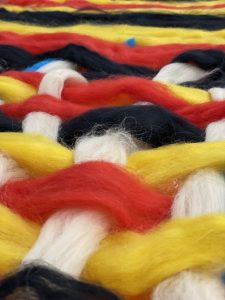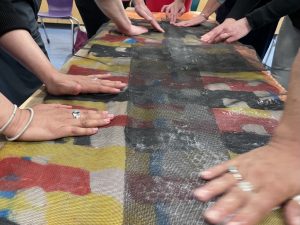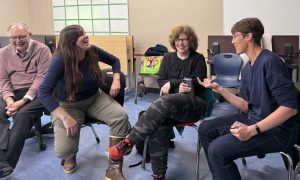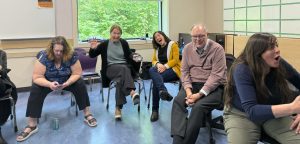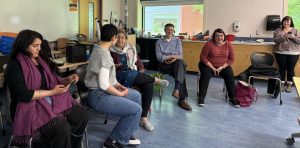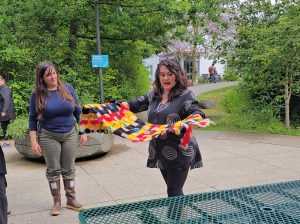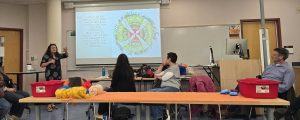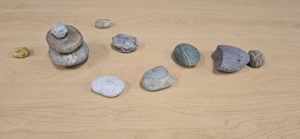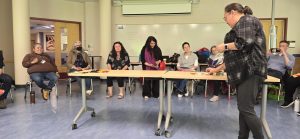Written by Vandy Britton
I had the extraordinary pleasure of attending a professional development day hosted by Senóqw’iye (Leanne Joe) from UFV’s Teaching & Learning Centre that was centered around the newly envisioned Environmental Learning Experience (ELE) Framework. This curriculum had been put on the back burner by the Ministry, but through the tireless work of Dr. David Zandvliet (SFU), Dr. Shannon Leddy (UBC), and their team (including graduate students, Alisa Paul (SFU/UBC), and our very own Leanne Joe), the ELE has been reimagined into something significant and relevant to learning for both K-12 and post-secondary.
Our day began in circle with Senóqw’iye (Leanne) talking about the importance of story. She shared, “Storytelling is foundational to any Indigenization.” Thus, we began by sharing some of our own stories. First, we went around the circle and shared our names. Then Senóqw’iye asked us a question: “What does the environment or sustainability mean to you?” We were to share a single word that, for us, would sum up this understanding. ‘Connection’ was a key theme shared by many of the participants. For myself, I shared the word tómiyeqw (the word for both a great, great, great, great-grandparent and a great, great, great great-grandchild). This Halq’eméylem word has come to become quite important to my understanding about Stó:lō peoples; but also to my own understanding of how the choices that I make in my life impact others.
After this, Leanne’s colleague, Alisa, handed out a pocket-sized whiteboard and felt pen to each of us and we were asked to “draw a picture of storytelling”. I drew a spiral on my whiteboard because, to me, storytelling is circular; that is, we hear a story and learn something, and then we can hear the same story again, but we don’t ‘hear’ it the same way because we are now different than the first time that we heard it. We were then asked to talk about what we drew with a person sitting beside us. After a brief discussion with my ‘elbow partner’, we were then prompted to “draw a lesson that we had learned from storytelling”. Then, finally, Senóqw’iye asked us to think about what superpower we wished we had and then consider how this superpower could help with environmental sustainability.
Senóqw’iye then talked about the power of story as a teaching tool, and the two kinds of stories – the sxwōxwiyám (origin stories) and sqwélqwel (news or true stories) – that are significant to the Temexw (land) of the Stó:lō. I say it this way because, as Senóqw’iye said, “The stories come from the land; they are of the land. So, the stories belong to the land.” She shared that the wisdom is passed down to the younger generations by the Elders, and that much of her own learning about her culture has been learned this way. Through this conversation, the activities we had previously engaged in began to make sense.
The ’glue’ that tied it all together was when Senóqw’iye and her colleagues introduced the ELE Framework. The actual introduction to the entire document is the origin story for Sts’ailes (Chehalis) First Nation, where Senóqw’iye was raised. This sxwōxwiyám provides all the reasons necessary to understand the importance of discussing environmental sustainability in our classrooms. It teaches us how insignificant humans are in terms of our value in relation to the land and its inhabitants; and how we rely on the earth and all other beings (including the plants and trees) for our very existence. Yet, of course, we are the ones who cause the most damage and harm. The phrase “all my relations” is strongly represented in this story as the learning behind the story is about the interconnectedness of all of us.
The story begins with how the earth was created and then how Creator asked the other beings on Mother Earth to help these new creatures (humans) since they couldn’t survive on their own. All the animals and plants, in turn, said that they would help these helpless beings; and they asked for only one thing in return – respect. And that is what humans are to do – respect – all my (our) relations.
We then spent some time reviewing the ELE document under the guidance of Dr. Shannon Leddy. The curriculum document has many different sets of principles and ideas that stand on their own but are also interconnected. For instance, the First Peoples Principals of Learning (FNESC, 2006) and the 4 Rs of Indigenous Education (Kirkness & Barnhardt, 2001) are both present, as is Yunkaporta’s 8 ways of learning (2009) that was discussed in relation to both the Medicine Wheel teachings and Stó:lō Storytelling. Then, when these concepts were connected with the 7 Es of experiential learning (Eisenkraft, 2003), the overlaps between all the principles, ideas and ways of being and learning were easily identifiable. These cross-curricular connections help to make the learning plain for students and allow for multiple points of entry and understanding.
The afternoon was spent both (both literally and figuratively) weaving all our thoughts and connections together, as Dr. Leddy led us through an arts-based learning activity. We literally made a felted blanket together in about 90 minutes. The blanket was then cut up into small pieces so that we would each have a tangible memento to take home with us from our day of learning. I kept thinking how the whole day really highlighted the value behind Etuaptmumk or two-eyed seeing, an idea that Mi’kmaq Elder and scholar, Albert Marshall, uses to describe the process of learning to see from one eye with an Indigenous lens and one eye with a Western lens – and then using them both for the benefit of everyone. The work of environmental sustainability really is the work of all of us. And reviewing the ELE Framework was a great place to start.
Thank you, Leanne!
“The ELE workshop provided a unique opportunity to build connections – connections with the humans in the room, connections with our environment, and connections with our work. It was so special to witness people from all different areas come together around common goals and values and share our time and energy with one another.”
“I found the Environmental Learning Experience Framework workshop inspiring and enjoyable. The facilitators reminded us how refreshing it is to learn by storytelling, by collaborating, by creating with your bare hands, and by exploring the natural world right outside the door.”
“The ELE workshop provided an important opportunity to gather with colleagues across UFV who are also thinking deeply about sustainability in education and our facilitators generously shared the framework they have been working on. Most notable for me was the opening storytelling panel facilitated by Leanne Joe, wherein she noted the agency we have even as our non-super hero selves to help the environment, as well as shared Stó꞉lō teachings on Sxwōxwiyám and Sqwélqwel. I also enjoyed the open playfulness as Dr. Shannon Leddy led us in a collective weaving exercise.”

